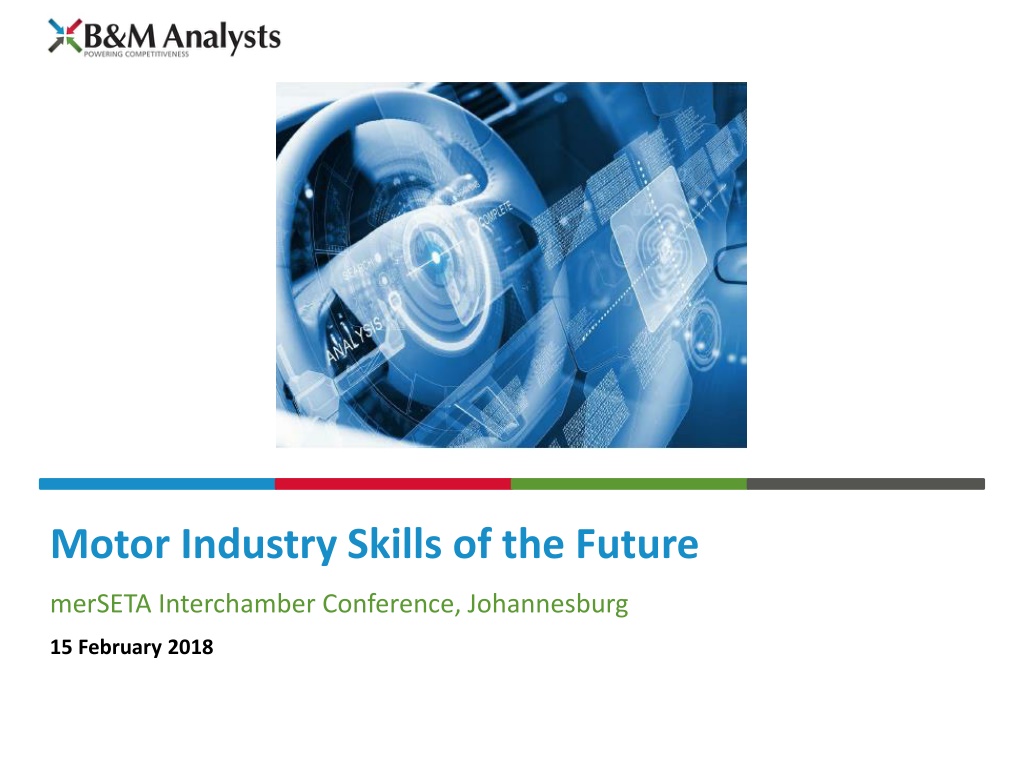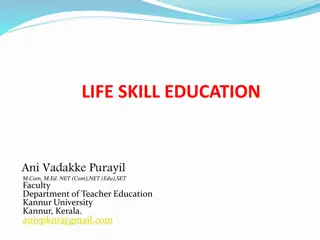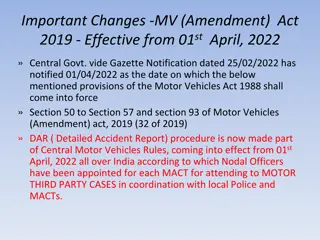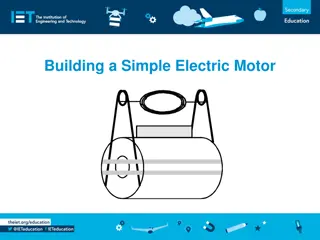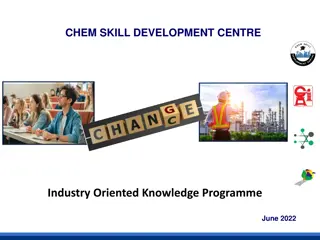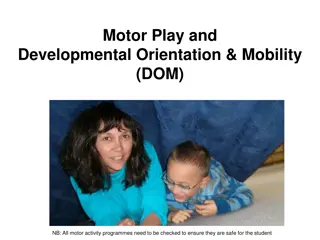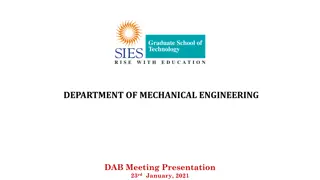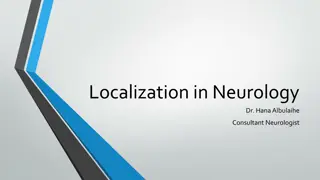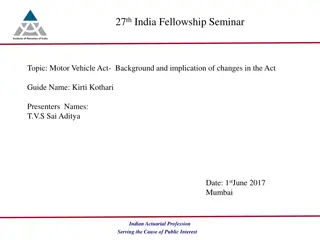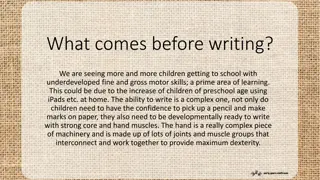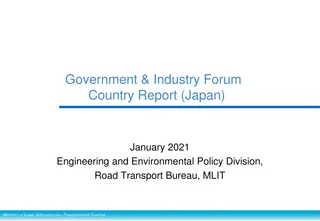Future Skills in the Motor Industry: Meeting Challenges and Opportunities
Explore the transformative landscape of the motor industry with a focus on skills and occupations, delving into disruptive changes, the South African Automotive Master Plan, and the implications for future skill development. The research methodology includes primary and secondary research, workshops, and consultations to understand the evolving skill requirements in the automotive sector.
Download Presentation

Please find below an Image/Link to download the presentation.
The content on the website is provided AS IS for your information and personal use only. It may not be sold, licensed, or shared on other websites without obtaining consent from the author. Download presentation by click this link. If you encounter any issues during the download, it is possible that the publisher has removed the file from their server.
E N D
Presentation Transcript
Motor Industry Skills of the Future merSETA Interchamber Conference, Johannesburg 15 February 2018
Introduction 1. Project overview 2. Disruptive changes to the global automotive industry 3. The South African Automotive Master Plan (SAAM) 4. Domestic implications on occupations and skills requirements 5. Next steps: Stakeholder engagement process Appendices 2
Project overview Primary research question: INVESTIGATE THE RELEVANCY OF OCCUPATIONS AND SKILLS FOR THE MOTOR INDUSTRY Related questions: How will South Africa respond to the challenges presented by disruptive technological changes in global automotive value chains? What skills development is needed and available for people to adapt and remain relevant to these changes? How to align SA s automotive manufacturing policy framework to respond to these challenges to 2035 through the South African Automotive Master Plan (SAAM)? 4
Project overview Global Value Chain shifts (technology, players and geographies) SAAM supports SA s position in the global value chains Skills implications Job types Job categories How do we address these implications? 5
Methodology Two areas of study: Tier-1 component manufacturers for OEM s (B&M Analysts) Automotive dealer and distribution establishments of approved franchised OEM motor vehicle, bus, truck and tractors service centres and repairers (MIBCO) Methodology Secondary Research: Desktop research Analysis of internal and external resources. Focus Groups: Workshops to be held in Johannesburg, Port Elizabeth and Durban Determining what skills are needed for these existing occupations and what new skills will be required Determining the skills development resources required to skill people sufficiently to fulfil these occupations Quantitative primary research: Preparation of a questionnaire, guided by desktop research and focus group output Consultation and follow up with organisations to obtain data Compilation of data per research group Presentation and interpretation of data as part of the consolidated research report (23rd March). 6
2. Disruptive changes to the global automotive industry
A number of technological trends are set to disrupt the global auto industry Move to Plug-in hybrid electric vehicles (PHEVs), then battery electric vehicles (BEVs), as battery costs plummet and environmental regulations tighten. Simultaneous move to high technology, smaller displacement internal combustion engines (ICEs). 1 Alternative engine technologies 2 Regulatory and consumer demand for carbon-neutral production processes, recycled material and reduced emissions. What are the compliance cost implications? Green manufacturing 3 Development of composites, embedded nano-technology, and durable, light materials to reduce the weight of vehicles (resulting in improved emissions and fuel economy). New materials design Infotainment and vehicle connectivity developments (IoT) 4 Internet and satellite connectivity leading to improved in-vehicle entertainment and navigation capabilities. 5 Robotics and artificial intelligence Rise of machine learning, big data and robotics will lead to product and process improvements. 6 Passive and active vehicle safety advances Introduction of new safety features will reduce collisions and road casualties but lead to a bifurcation of consumer markets as costs rise. 7 Mobility services & autonomous vehicles Alternative transport solutions (e.g. autonomous fleets of on-demand EVs) have the potential to displace private vehicle ownership. 8
The Smiling Curve of value addition Valueaddition After sales service Branding and sales Manufacturing Assembly R&D Stage of production Value addition is increasingly located in the areas of R&D and after sales service, which concentrates value in the hands of OEMs and service sectors. SA s current space, at bottom of curve, will be further challenged as the GVC pressures drive down value addition opportunities in manufacturing and assembly. 9
3. The South African Automotive Master Plan (SAAM)
Background to the South African Automotive Master Plan (SAAM) The local automotive industry is a marginal player globally, contributing only 0.65% of global vehicle output. Production output of 600,000 units in 2016. Local content levels within South African vehicles declining to 38% in 2015, from 47% in 2012 Despite manufacturing output contracting to only 13.2% of GDP in 2016 from 23.6% in 1990 (World Development Indicators), the automotive industry s comparative resilience, its established foundations, direct employment (approximately 112,000 jobs), export contribution, and its recognized technology multipliers, have positioned it as a core, strategic industrial sector within the South African economy. Motor Industry Development Programme (MIDP) from 1995 to 2012, Automotive Production Development Programme (APDP), which was introduced in 2013, and which is presently set to run until 2020. Government also introduced the Automotive Investment Scheme (AIS) that provides cash grant support for greenfield and brownfield investments of up to 35% of the total investment amount. 11
The SAAMs 2035 vision, objectives, and strategic implementation pillars 2035 vision A globally competitive and transformed industry that actively contributes to the sustainable development of South Africa s productive economy, creating prosperity for industry stakeholders and broader society Key objectives: 1% of global vehicle production, up to 60% local content, 100% employment growth, competitiveness to leading competitor standards, transformation of the auto value chain, increased value addition Technology and associated skills development 6 Infrastructure development Industry transformation Local market optimisation Localisation Regional market development 1 2 3 4 5 Supporting institutional environment (including monitoring and evaluation) Enabling policy post-2020 12
Summary of SAAM objectives and estimated impact on South African automotive industry Objective Estimated impact on SA auto industry CBU production to 1.39 million units annually (129% higher than 2015 levels) Increase of value of vehicle production to R314 billion 1. Grow SA vehicle production to 1% of global output Increase of R135.4 billion on 2015 local content levels Local content increase of 21.3% per vehicle produced (55% increase) Increase automotive component aftermarket and export production by at the same pace as local content growth 2. Increase local content in SA assembled vehicles to up to 60% Employment growth of 112,000 Aggregate employment from 112,000 to 124,000 3. Double employment in the auto value chain Sustainable automotive industry based on comparative price and non-price competitiveness versus leading international competitiveness Sustained export competitiveness 4. Improve auto industry competitive levels to that of leading international competitors 25% Black-owned involvement at Tier 2 and Tier 3 component manufacturer levels, as well as in dealership networks and authorised repair facilities Amplified skills development of Black South Africans Enhanced employment equity at senior management, artisan and professional employment levels across automotive value chain 5. Transformation of the South African automotive value chain Growth in R&D and other innovation metrics within the South African automotive value chain 6. Deepen value addition within SA auto value chains 13
How does the SAAM respond to technological & skills development needs to 2035? New types of industrial infrastructure will need to be understood and responded to, to ensure SA does not fall too far behind the automotive technology frontier, and that domestic production continues to qualify for supply into developed economy markets (increasing efficiency and emissions requirements are likely to represent new forms of Trade Barriers in future). Production technologies TEECHNOLOGY As product development and production processes within the automotive industry become more environmentally sustainable, there will also be clear requirements for the deployment of new production technologies in South Africa. Environmental sustainability South Africa has a discreet set of automotive-linked materials supply that will need to be developed in alignment with the evolution of new automotive technologies. Platinum Group Metals, aluminium, and certain grades of steel, represent core areas of potential sustained competitive advantage for the South African automotive industry New materials It is critical that the technology roadmap developed for the South African automotive industry to 2035 includes a linked skills development plan. Skills development The global automotive industry s skills requirements are advancing in tandem with technology advances. This requires a fundamental shift in both the number and the level of skilled personnel being recruited into the South African automotive industry. SKILLS Human capital SA s global automotive competitors are developing skills in advance of industry requirements to ensure that skills bottlenecks do not stunt the growth and development of their industries. The domestic automotive industry, working in partnership with government and other social partners, should follow a similar model. Keeping up with the competition 14
4. Domestic implications on occupations and skills requirements
What is the existing employment profile across various sub-sectors? Manage ment Firm type Professional Supervisor Artisan Production Other Most employees are production workers (68% average). Lowest skill profile are vulnerable to GVC disruptors and diminishing local value addition. Components 7% 3% 6% 3% 74% 7% Electronics 3% 5% 8% 2% 71% 11% Foundry/forge 3% 2% 9% 10% 61% 14% Glass 2% 3% 12% 4% 71% 8% Harnesses 3% 4% 9% 1% 73% 11% Heat transfer 5% 9% 7% 6% 53% 21% JIT Assembly 3% 16% 6% 5% 62% 8% Second highest employment categories per sector. Are these categories prepared for GVC disruption? Metal fabrication 7% 3% 7% 6% 69% 8% Metal form/press 7% 8% 8% 4% 64% 9% Other (paint/rubber) 5% 6% 7% 4% 71% 8% Lowest employment categories per sector. Are these categories at risk of disappearing altogether? Plastic Moulding 8% 5% 5% 6% 73% 3% Precision Machining 0% 1% 11% 27% 57% 3% Trim 4% 2% 6% 3% 81% 4% Average 4% 5% 8% 6% 68% 9% 16 Source: BMA benchmark database (sample of 82 automotive supplier firms), 2016
What are the implications of GVC disruptors on management capabilities in SA? Soft Skills Technical Skills ASCCI Skills Development Framework* Leader- ship & team- building Vision and change manage- ment Conflict mgmt & negotia- tion Time mgmt & delegation Computer literacy / ICT Global thinking Business financials New skills? WCM 1. Alternative engine technologies 2. Green manufacturing 3. New materials design GVC disruptors 4. Infotainment and vehicle connectivity (IoT) 5. Robotics and artificial intelligence 6. Passive & active vehicle safety advances 7. Mobility services 17 *Source: Automotive Supply Chain Competitiveness Initiative (ASCCI) High Level Skills Framework (2017)
What are the implications of GVC disruptors on professional capabilities in SA? Soft Skills Technical Skills Manufact- uring & assembly tech- niques ASCCI Skills Development Framework* Leader- ship & team- work Visual process mgmt. (leading) Work Ethics & Values Time mgmt. Self- mgmt. Business financials New skills? WCM 1. Alternative engine technologies 2. Green manufacturing 3. New materials design GVC disruptors 4. Infotainment and vehicle connectivity (IoT) 5. Robotics and artificial intelligence 6. Passive & active vehicle safety advances 7. Mobility services 18 *Source: Automotive Supply Chain Competitiveness Initiative (ASCCI) High Level Skills Framework (2017)
What are the implications of GVC disruptors on supervisor capabilities in SA? Soft Skills Technical Skills ASCCI Skills Development Framework* Leader- ship & team- building Visual process mgmt. (leading) Health, safety & environ- ment Time mgmt. Conflict mgmt. New skills? Training Quality Lean 1. Alternative engine technologies 2. Green manufacturing 3. New materials design GVC disruptors 4. Infotainment and vehicle connectivity (IoT) 5. Robotics and artificial intelligence 6. Passive & active vehicle safety advances 7. Mobility services 19 *Source: Automotive Supply Chain Competitiveness Initiative (ASCCI) High Level Skills Framework (2017)
What are the implications of GVC disruptors on artisan capabilities in SA? Soft Skills Technical Skills Business Literacy (how a business works) Tech drawings & measure- ments ASCCI Skills Development Framework* Visual process mgmt. (doing) Health, safety & environ- ment Work ethics & values Personal finance Computer basics New skills? Training 1. Alternative engine technologies 2. Green manufacturing 3. New materials design GVC disruptors 4. Infotainment and vehicle connectivity (IoT) 5. Robotics and artificial intelligence 6. Passive & active vehicle safety advances 7. Mobility services 20 *Source: Automotive Supply Chain Competitiveness Initiative (ASCCI) High Level Skills Framework (2017)
What are the implications of GVC disruptors on production capabilities in SA? Soft Skills Technical Skills Visual Process Mgmt (Partici- pating) ASCCI Skills Development Framework* Health, safety & environ- ment Code of conduct Team- work Personal finance Time mgmt. New skills? 5S 7 Wastes 1. Alternative engine technologies 2. Green manufacturing 3. New materials design GVC disruptors 4. Infotainment and vehicle connectivity (IoT) 5. Robotics and artificial intelligence 6. Passive & active vehicle safety advances 7. Mobility services 21 *Source: Automotive Supply Chain Competitiveness Initiative (ASCCI) High Level Skills Framework (2017)
Stakeholders feedback will be solicited at several industry workshops Focus group workshops will be conducted in Johannesburg, Durban and Port Elizabeth as follows: Johannesburg: 19 February 2018 x2 component manufacturers (facilitated by BMA), Automotive dealer and distribution establishments (facilitated by MIBCO) Port Elizabeth: 22 February 2018 x1 component manufacturers (facilitated by BMA) Durban: 27 February 2018 x1 component manufacturers (facilitated by BMA) Interview with OEM Automotive Body Repair establishments: Approved Repairer - x6 (facilitated by MIBCO) Automotive dealer and distribution establishments - x3 (facilitated by MIBCO) Two research groups: Tier 1 component manufacturers (facilitated by BMA); Automotive dealer and distribution establishments (facilitated by MIBCO). 23
References Barnes, J.: GVC disruptors and the South African automotive industry Durban Automotive Cluster Executive Development Programme (workshop); B and M Analysts, 2017 Barnes, J. & Black, A.: Developing a South African automotive Masterplan to 2035 in the context of Global Value Chain drivers: Lessons for second tier automotive economies, paper prepared for the GERPISA Colloquium, Paris, France, 14-16 June 2017 High Level Skills Framework, Automotive Supply Chain Competitiveness Initiative (ASCCI), 2017 White, J. & Ellis, S.: Supplier skills needs assessment and leadership needs analysis project , Automotive Supply Chain Competitiveness Initiative (ASCCI), 2017 24
B&M Analysts provides competitiveness benchmarking and upgrading, cluster facilitation, project management and facilitation, and policy and strategy research services to the private sector, local government, provincial government, national government and NGOs. Established in 1997, we have a wealth of expertise that spans the automotive manufacturing, apparel and textile manufacturing, furniture manufacturing, chemicals manufacturing, agro processing and retailing sectors. Through the application of our established methodologies we assist oganisations that we work with to assess competitiveness in the global marketplace, support adherence to key industry standards, and unlock hidden potential. B&M Analysts s headquartered in Durban (South Africa) and has offices in Cape Town and Johannesburg (South Africa).
The SAAM would enable local automotive industry to substantially increase its contribution to the SA economy to 2035, with production, local content & employment growing significantly Production 2015 (base) 2020 449,619 118,681 330,938 2025 560,308 147,898 412,409 2030 2035 Passenger vehicles (units) PV - local market PV exports PV - local market (%) 870,141 229,682 640,459 26.40 341,025 112,566 228,459 698,245 184,308 513,937 33.01 26.40 26.40 26.40 PV - exports (%) 73.60 66.99 73.60 73.60 73.60 LCVs LCV - local market LCV exports LCV - local market (%) 479,232 247,046 232,186 51.55 242,974 140,310 102,664 286,049 147,459 138,590 339,737 175,136 164,601 403,501 208,006 195,495 57.75 51.55 51.55 51.55 LCV - exports (%) 48.45 42.25 48.45 48.45 48.45 Light vehicles LVs - local market LVs - exports LVs - local market (%) 1,349,373 476,728 872,645 35.33 583,999 252,876 331,123 735,669 266,141 469,528 900,044 323,034 577,010 1,101,746 392,315 709,431 43.30 36.18 35.89 35.61 LVs - exports (%) 64.67 56.70 63.82 64.11 64.39 M&HCVs Total Avg. value of SA vehicle Value of production (Rm) Local content (%) 42,615 1,391,988 225,804 314,317 60.00 24,303 608,302 225,804 137,357 27,353 763,022 225,804 172,293 31,710 931,754 225,804 210,394 36,760 1,138,506 225,804 257,079 38.70 43.18 48.19 53.77 Local content value (Rm) Employment (productivity adjusted) 188,589 224,000 53,157 112,000 74,403 129,570 101,382 151,882 138,231 182,355 Source: Barnes, J. & Black, A.: Developing a South African automotive Masterplan to 2035 in the context of Global Value Chain drivers: Lessons for second tier automotive economies (2017) 27
